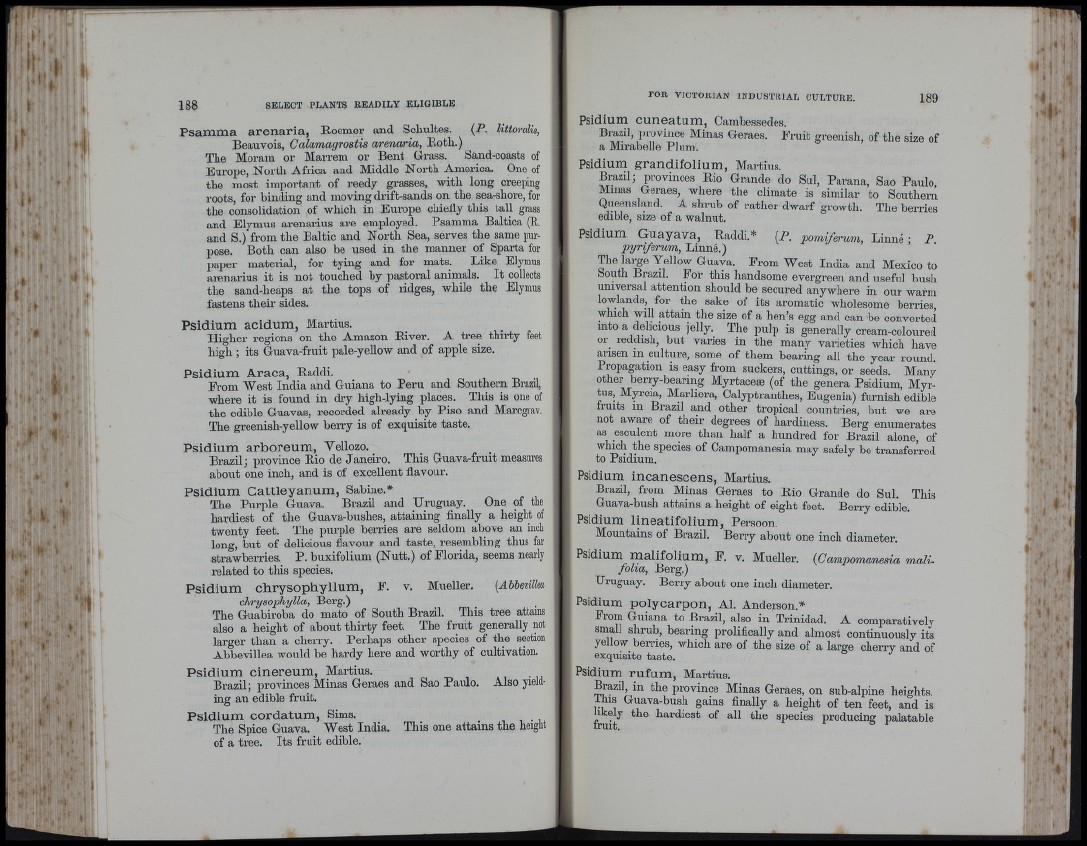
t. i
IT 1. k , ri i
1 1
h
I;
i't
|l ni !
’i U
' ''
h "i'' ' '
r -
à i. a.
, t : u
'■ I
I I
A ■
,i
«
■''r
'T"
■11'
t -1
H'
K
A l
ü i
; *
188 SELECT PLANTS READILY ELIGIBLE
Psamma arenaria, Boemer and Schultes. (P. littoralis,
Beauvois, Calamagrostis arenaria, Both.)
The Moram or Marrem or Bent Grass. SRnd-coasts of
Europe, North Africa and Middle North America. One of
the most important of reedy grasses, with long creeping
roots, for binding and moving drift-sands on tbe sea-shore, for
the consolidation of which in Europe chiefly this tall grass
and Elymus arenarius are employed. Psamma Baltica (R.
and S.) from the Baltic and North Sea, serves the same purpose.
Both can also be used in the manner of Sparta for
paper material, for tying and for mats. Like Elymus
arenarius it is not touched by pastoral animals. I t collects
tbe sand-lieaps at the tops of ridges, while the Elymus
fastens their sides.
Psidium acidum, Martius.
Higher regions on the Amazon Hiver. A tree thirty feet
h ig h ; its Guava-fruit pale-yellow and of apple size.
Psidium Araca, Baddi.
From West India and Guiana to Peru and Southern Brazil,
where it is found in dry high-lying places. This is one of
the edible Guavas, recorded already by Piso and Marcgiav,
The greenish-yellow berry is of exquisite taste.
Psidium arboreum, Yellozo.
Brazil; province Bio de Janeiro. This Guava-fruit measures
about one inch, and is of excellent flavour.
Psidium Cattleyanum, Sabine.*
The Purple Guava. Brazil and Uruguay. One of the
hardiest of the Guava-bushes, attaining finally a height of
twenty feet. The purple berries are seldom above an mch
long, but of delicious flavour and taste, resembling thus far
strawberries. P. buxifolium (Nutt.) of Florida, seems nearly
related to this species.
Psidium chrysopbyllum, E. v. Mueller. {Abbevillm
chrysophylla, Berg.)
The Guabiroba do mato of South Brazil. This tree attains
also a height of about thirty feet. The fruit generally not
larger than a cherry. Perhaps other species of the section
Abbevillea would be hardy here and worthy of cultivation.
Psidium cinereum, Martins.
Brazil; provinces Minas Geraes and Sao Paulo. Also yielding
an edible fruit.
Psidium cordatum, Sims.
The Spice Guava. West India. This one attains the height
of a tree. Its frait edible.
FOR VICTORIAN INDUSTRIAL CULTURE. 189
Psidium cuneatum, Cambessedes.
Brazil, province Minas Geraes. Fruit greenish, of the size of
a Mirabelle Plum.
Psidium grandifolium, Martins.
Brazil; provinces Bio Grande do Sul, Parana, Sao Paulo,
Mmas Geraes, where the climate is similar to Southern
Queensland. A shrub of rather dwarf growth. The berries
edible, size of a walnut.
Psidium Guayava, Baddi.* (P. pomiferum, Linné; P.
pyriferumy Linné.)
The laige Yellow Guava. From West India and Mexico to
South Brazil. For this handsome evergreen and useful bush
universal atte.ntion should be secured anywhere in our warm
lowlands, for the sake of its aromatic wholesome berries,
which will attain the size of a hen’s egg and can be converted
mto a delicious jelly._ The pulp is generally cream-coloured
or^ reddish, but varies in the many varieties which have
arisen in culture, some of them bearing all the year round.
Propagation is easy from suckers, cuttings, or seeds. Many
other beriy-bearing Myrtaceæ (of the genera Psidium, Myrtus,
Myrcia, Marliera, Calyptranthes, Eugenia) furnish edible
fruits in Brazil and other tropical countries, but we ai’e
not aware of their degrees of hardiness. Berg enumerates
as esculent more than half a hundred for Brazil alone, of
which the species of Campomanesia may safely be transferred
to Psidium.
Psidium incanescens, Martins.
Brazil, from Minas Geraes to Bio Grande do Sul. This
Guava-bush attains a height of eight feet. Berry edible.
Psidium lineatifolium, Persoon.
Mountains of Brazil. Berry about one inch diameter.
Psidium malifolium, F. v. Mueller. (Campomanesia mali-
folia, Berg.)
Uruguay. Berry about one inch diameter.
Psidium polycarpon, Al. Anderson.*
Fiom Guiana to Brazil, also in Trinidad. A comparatively
small shrub, bearing prolifically and almost continuously its
yellow berries, which are of the size of a large cherry and of
exquisite taste.
Psidium rufum, Martius.
Brazil in the province Minas Geraes, on sub-alpine heights,
ihis Guava-bush gains finally a height of ten feet, and is
fr t of all the species producing palatable ! I
V I'